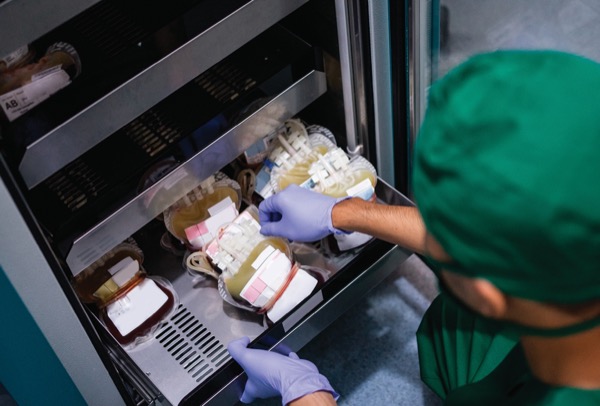An in vitro evaluation of cold-stored whole blood at a Level 1 trauma center found marked degradation in platelet function, dysfunction that was evident as early as the eighth day of storage. Interestingly, while platelet function was below normal in almost three-fourths of whole-blood units, it was found to be within the normal range in all reconstituted whole-blood samples.
“Our institution started to receive a small number of whole-blood units per week to use toward our massive transfusion protocol,” said Brian Czarkowski, MD, an assistant professor of surgery at the Creighton University School of Medicine, in Phoenix. “Due to the low number of units allocated to us each week, we started to wonder if it was worth the cost of incorporating the whole blood into our massive transfusion protocol, and whether or not the whole blood was having a clinical improvement in patient outcomes.”
Indeed, while cold-stored whole blood has seen increasing use in the civilian trauma setting, the effect of storage on hemostatic efficacy remains a concern, especially in terms of platelet function. With that in mind, the investigators sought to evaluate the thromboelastogram (TEG) profiles of emergency-release whole-blood units kept on hand at their Level 1 trauma center’s blood bank.
To that end, TEG 6S tracings were obtained from samples of 10 whole-blood units and 10 samples of reconstituted whole blood (1:1:1 red blood cells, fresh frozen plasma thawed on the day of testing, seven-day-old platelets) provided by the institution’s blood bank. The researchers compared several TEG parameters—R time (time to blood clot initiation), functional fibrinogen and maximum amplitude—between groups, which were then analyzed by length of storage.
In a presentation at the 2025 Eastern Association for the Surgery of Trauma Annual Scientific Assembly (EAST; paper 17), R times were found to be within the normal range for all samples of whole blood and reconstituted whole blood. Analyses of functional fibrinogen revealed that 2 out of 10 whole-blood samples were below the normal range, whereas none of the reconstituted whole-blood samples were below normal range (P=0.146).
The most significant difference between the groups was observed in maximum amplitude, where seven whole-blood samples were found to be below the normal range, compared with none of the reconstituted whole-blood samples (P<0.001). Similarly, all the reconstituted whole-blood maximum amplitude values were higher than all corresponding whole-blood maximum amplitude values. Finally, no correlation was found between whole-blood maximum amplitude values and sample storage age.
“We also showed that the age of blood did not affect this abnormality, as the dysfunction was seen as early as day 6,” Czarkowski told Anesthesiology News.
As Czarkowski went on to discuss, the whole-blood degradation observed in the study may be caused by the leukocyte reduction filters used during its processing.
“Even though it is marketed as platelet-sparing, we think this most likely contributed to the abnormalities seen in our results,” Czarkowski said. The cold-storage process may also play a role in this degradation, he added. “In order to mitigate this, I think the solution is in using fresh, warm whole blood or using cold-stored whole blood that is not leukoreduced.”
Given these findings, the researchers noted that platelet function in cold-stored whole blood seems to be markedly impeded. Further research is planned, Czarkowski said.
“We found this study to be very interesting and it seemed to gain a lot of attention at EAST,” he concluded. “I think further study should be aimed at comparing leukoreduced and non-leukoreduced whole blood.”
Kimberly L. Skidmore, MD, a clinical professor of anesthesia at Louisiana State University Health, in Shreveport, said back in the 1960s, platelets were chilled, although even then it was recognized that cold compromises function.
“In 2023,” she said, “the FDA approved immediately chilled apheresis platelets to be used for 14 days. This can help the shortage compared to platelets stored at room temperature, which have a limit of seven days. This new abstract is a critical addition to the literature because we need to go back to whole blood to alleviate the platelet component shortage. There is an extreme shortage in 2025, so chilled platelets are better than none at all.”
However, Skidmore noted that other research has highlighted the potential drawbacks associated with cold-stored blood, including a trial (Anesthesiology 2023;139[2]:153-163) of 713 cardiac surgery patients who received either room temperature–stored platelets or delayed cold-stored platelets. The study found that patients receiving cold-stored platelets had a 65% greater odds of allogeneic transfusion in the first 24 hours postoperatively.
Skidmore was pleasantly surprised to find that in the current study, maximum amplitude was not worse after one month of cold storage. “Maximum amplitude was quite low in all cases, and we do not know clinically if those platelets contribute much to clotting,” she noted.
“Leeper showed maximal amplitude was not different and platelet transfusions were decreased in trauma patients after cold whole blood versus components, despite whole blood being leukoreduced,” Skidmore added (Ann Surg 2020;272[4]:590-594).
By Michael Vlessides
Czarkowski and Skidmore reported no relevant financial disclosures.



Please log in to post a comment